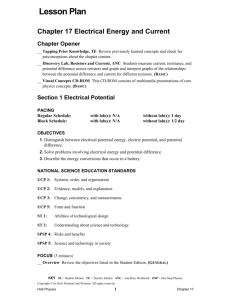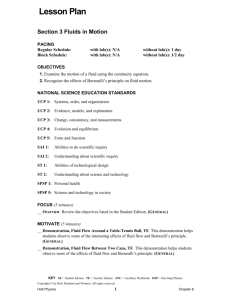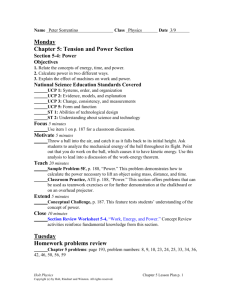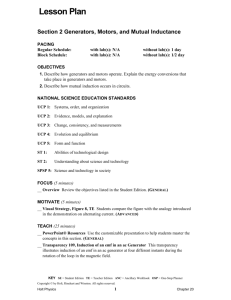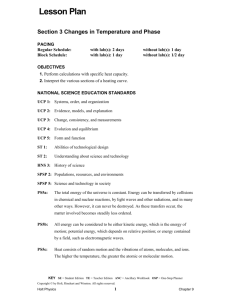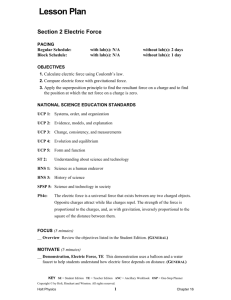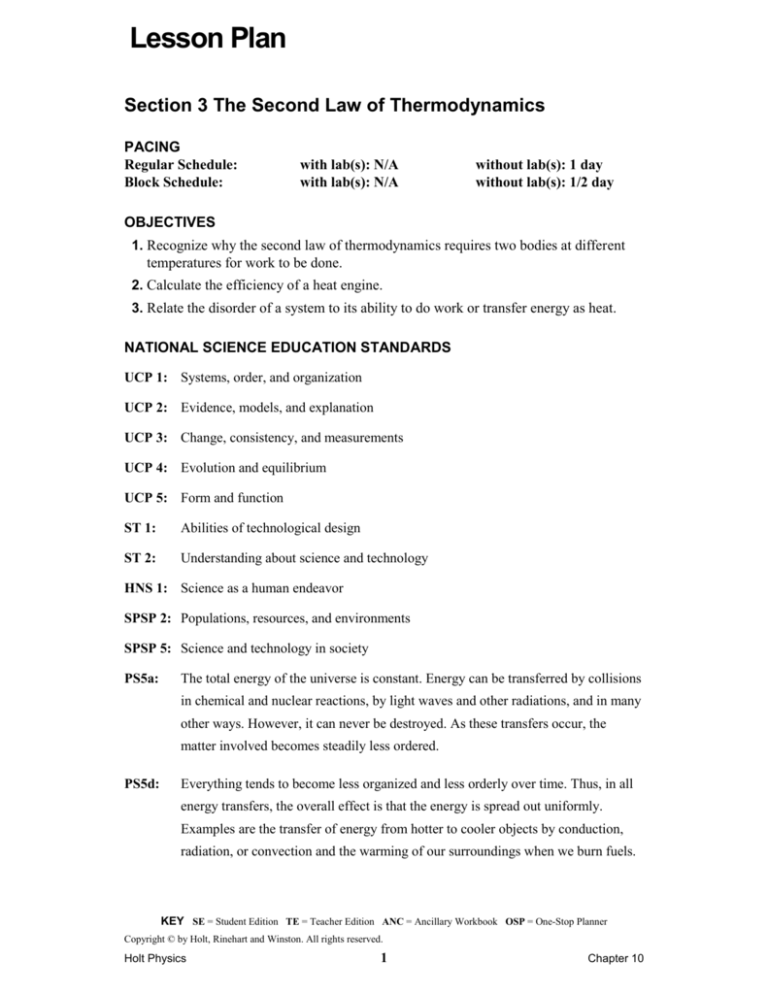
Lesson Plan
Section 3 The Second Law of Thermodynamics
PACING
Regular Schedule:
Block Schedule:
with lab(s): N/A
with lab(s): N/A
without lab(s): 1 day
without lab(s): 1/2 day
OBJECTIVES
1. Recognize why the second law of thermodynamics requires two bodies at different
temperatures for work to be done.
2. Calculate the efficiency of a heat engine.
3. Relate the disorder of a system to its ability to do work or transfer energy as heat.
NATIONAL SCIENCE EDUCATION STANDARDS
UCP 1: Systems, order, and organization
UCP 2: Evidence, models, and explanation
UCP 3: Change, consistency, and measurements
UCP 4: Evolution and equilibrium
UCP 5: Form and function
ST 1:
Abilities of technological design
ST 2:
Understanding about science and technology
HNS 1: Science as a human endeavor
SPSP 2: Populations, resources, and environments
SPSP 5: Science and technology in society
PS5a:
The total energy of the universe is constant. Energy can be transferred by collisions
in chemical and nuclear reactions, by light waves and other radiations, and in many
other ways. However, it can never be destroyed. As these transfers occur, the
matter involved becomes steadily less ordered.
PS5d:
Everything tends to become less organized and less orderly over time. Thus, in all
energy transfers, the overall effect is that the energy is spread out uniformly.
Examples are the transfer of energy from hotter to cooler objects by conduction,
radiation, or convection and the warming of our surroundings when we burn fuels.
KEY SE = Student Edition TE = Teacher Edition ANC = Ancillary Workbook OSP = One-Stop Planner
Copyright © by Holt, Rinehart and Winston. All rights reserved.
Holt Physics
1
Chapter 10
Lesson Plan
FOCUS (5 minutes)
__ Overview Review the objectives listed in the Student Edition. (GENERAL)
MOTIVATE (5 minutes)
__ Teaching Tip, p. 353, TE Work through a simple numerical example to help students
understand the meaning of efficiency. (GENERAL)
TEACH (25 minutes)
__ PowerPoint® Resources Use the customizable presentation to help students master the
concepts in this section. (GENERAL)
__ Transparency 43, Low and High Entropy Systems This transparency illustrates both
the improbable/orderly and probable/highly disordered distributions of particle velocities
in a heat engine piston.
__ Transparency 44, Entropy Changes Produced by a Refrigerator Freezing Water
This transparency illustrates that the entropy of the air molecules outside a refrigerator
increases more than the entropy of the water freezing inside decreases.
__ Transparency Master 37A, Typical Efficiencies for Engines This transparency master
provides efficiencies for different types of engines.
__ Conceptual Challenge, p. 353, SE These conceptual questions challenge students to
apply the section content to real-world applications. (ADVANCED)
__ Sample Set C, Heat-Engine Efficiency, SE This sample and practice problem set covers
heat-engine efficiency. (GENERAL)
__ Classroom Practice, Heat-Engine Efficiency, TE Use this problem as a teamwork
exercise or for demonstration at the board or on an overhead projector. (GENERAL)
__ Demonstration, Probability, TE This demonstration uses pennies and a cup to
demonstrate that, in large systems, ordered arrangements are less probable that disordered
ones. (GENERAL)
__ Quick Lab, Entropy and Probability, SE Students write down the probability of
different combinations of dice rolls. (ADVANCED)
CLOSE (10 minutes)
__ Section Review, SE Students answer review questions, critical-thinking questions, and
interpreting-graphics questions that assess their understanding of the section objectives.
(ADVANCED)
__ Study Guide, The Second Law of Thermodynamics, ANC Use this worksheet to
review the main concepts presented in the section. (GENERAL)
__ Section Quiz, ANC Use this quiz to assess students' understanding of the section.
(GENERAL)
KEY SE = Student Edition TE = Teacher Edition ANC = Ancillary Workbook OSP = One-Stop Planner
Copyright © by Holt, Rinehart and Winston. All rights reserved.
Holt Physics
2
Chapter 10
Lesson Plan
OTHER RESOURCE OPTIONS
__ Holt Online Learning Students can access interactive problem-solving help and active
visual concept development with the Holt Physics Online Edition available at
go.hrw.com.
__ Integrating Environmental Science, Thermal Pollution, Online Students can visit
go.hrw.com and enter the keyword HF6TDYX to find this activity. Teacher resources can
be found by entering the keyword HF6TDYXT. (GENERAL)
__ Problem Workbook, Sample Set C: Heat-Engine Efficiency, ANC This worksheet
provides an additional example problem and several practice problems that cover heatengine efficiency. (GENERAL)
__ Problem Bank, Sample Set C: Heat-Engine Efficiency, OSP This worksheet provides a
third example problem and several practice problems that cover heat-engine efficiency.
(GENERAL)
__ SciLinks, Online Students can visit www.scilinks.org to find internet resources related
to the chapter content.
Topic: Stirling Engines
SciLinks Code: HF61455
__ SciLinks, Online Students can visit www.scilinks.org to find internet resources related
to the chapter content.
Topic: Entropy
SciLinks Code: HF60523
KEY SE = Student Edition TE = Teacher Edition ANC = Ancillary Workbook OSP = One-Stop Planner
Copyright © by Holt, Rinehart and Winston. All rights reserved.
Holt Physics
3
Chapter 10
Lesson Plan
End of Chapter Review and Assessment
PACING
Regular Schedule:
Block Schedule:
with lab(s): N/A
with lab(s): N/A
without lab(s): 2 days
without lab(s): 1 day
__ Chapter Highlights, p. 359, SE This page summarizes the vocabulary terms and key
concepts of the chapter.
__ Chapter Review, pp. 360–363, SE Students review the chapter material with review
questions, conceptual questions, practice problems, and a mixed review section.
__ Alternative Assessment, p. 363, SE These projects challenge students to apply and
extend concepts that they have learned in the chapter. (ADVANCED)
__ Graphing Calculator Practice, p. 362, SE Students program their graphing calculators
to predict the highest theoretical efficiency for a Carnot engine operating between various
temperatures. (GENERAL)
__ Standardized Test Prep, pp. 364–365, SE This feature helps students sharpen their testtaking abilities while reviewing the chapter content. (GENERAL)
__ Appendix D: Equations, p. 859, SE This appendix summarizes the equations introduced
in the chapter.
__ Appendix I: Additional Problems, pp. 888, SE This appendix provides additional
mixed practice problems that cover the equations introduced in the chapter.
__ Study Guide, Mixed Review, ANC Students can use this worksheet to review the main
concepts of the chapter in preparation for the chapter test. (GENERAL)
__ Holt PuzzlePro® Use this software to create crossword puzzles and word searches that
make learning vocabulary fun.
__ Chapter Test A, ANC Assign this test for general-level chapter assessment. (GENERAL)
__ Chapter Test B, ANC Assign this test for advanced-level chapter assessment.
(ADVANCED)
__ Test Generator Create a customized homework assignment, quiz, or test using the
ExamView® Test Generator.
__ Test Item Listing, OSP The Holt Physics Test Generator contains a file of test items for
each chapter of the textbook. This Test Item Listing is a print-out of all the test items in
the Test Generator for this chapter.
KEY SE = Student Edition TE = Teacher Edition ANC = Ancillary Workbook OSP = One-Stop Planner
Copyright © by Holt, Rinehart and Winston. All rights reserved.
Holt Physics
4
Chapter 10

